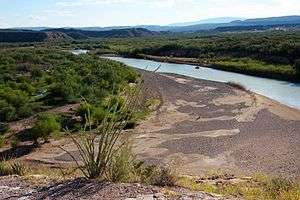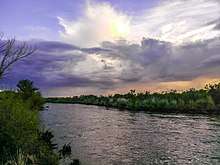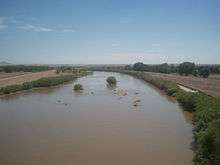Rio Grande
The Rio Grande (/ˈriːoʊ ˈɡrænd/ or /ˈriːoʊ ˈɡrɑːndeɪ/;[5][6][7] Spanish: Río Bravo del Norte, Spanish pronunciation: [ˈri.o ˈβɾaβo ðel ˈnoɾte] (![]()
| Rio Grande Río Bravo del Norte, Tooh Baʼáadii (in Navajo), Kótsoi (in Jicarilla Apache) | |
|---|---|
 The Rio Grande at Big Bend National Park, on the Mexico–U.S. border | |
 Map of the Rio Grande drainage basin | |
| Location | |
| Country | United States, Mexico |
| State | Colorado, New Mexico, Texas, Chihuahua, Coahuila, Nuevo León, Tamaulipas |
| Physical characteristics | |
| Source | Main stem source: Canby Mountain, Continental Divide |
| • location | San Juan Mountains, Rio Grande National Forest,[1] Colorado, United States |
| • coordinates | 37°47′52″N 107°32′18″W[2] |
| • elevation | 12,000 ft (3,700 m)[1] |
| 2nd source | Most distant source: Pole creek, Unnamed peak 13450, Continental Divide |
| • location | San Juan Mountains, Rio Grande National Forest,[1] Colorado, United States |
| • coordinates | 37°51′6″N 107°25′28″W |
| • elevation | 12,760 ft (3,890 m) |
| Mouth | Gulf of Mexico |
• location | Cameron County, Texas; Matamoros, Tamaulipas |
• coordinates | 25°57′22″N 97°8′43″W[2] |
• elevation | 0 ft (0 m) |
| Length | 1,896 mi (3,051 km)[1] |
| Basin size | 182,200 sq mi (472,000 km2)[3] |
| Discharge | |
| • location | Eagle Pass, Texas/Piedras Negras, Coahuila[4] |
| • average | 2,403 cu ft/s (68.0 m3/s)[4] |
| • minimum | 24 cu ft/s (0.68 m3/s) |
| • maximum | 964,000 cu ft/s (27,300 m3/s) |
| Basin features | |
| Tributaries | |
| • left | Red River, Rio Hondo, Rio Pueblo de Taos, Embudo River, Santa Fe River, Galisteo Creek, Alamito Creek, Terlingua Creek, Pecos River, Devils River |
| • right | Conejos River, Rio Chama, Jemez River, Rio Puerco, Rio Conchos, Rio Salado, Rio Alamo, San Juan River |
The river serves as part of the natural border between the U.S. state of Texas and the Mexican states of Chihuahua, Coahuila, Nuevo León, and Tamaulipas. A very short stretch of the river serves as part of the boundary between the U.S. states of Texas and New Mexico. Since the mid–20th century, heavy water consumption by farms and cities along with many large diversion dams on the river has left only 20% of its natural discharge to flow to the Gulf. Near the river's mouth, the heavily irrigated lower Rio Grande Valley is an important agricultural region.
The Rio Grande's watershed covers 182,200 square miles (472,000 km2).[3] Many endorheic basins are situated within, or adjacent to, the Rio Grande's basin, and these are sometimes included in the river basin's total area, increasing its size to about 336,000 square miles (870,000 km2).[9]
Geography

The Rio Grande rises in the western part of the Rio Grande National Forest in the U.S. state of Colorado. The river is formed by the joining of several streams at the base of Canby Mountain in the San Juan Mountains, just east of the Continental Divide. From there, it flows through the San Luis Valley, then south into the Middle Rio Grande Valley in New Mexico, passing through the Rio Grande Gorge near Taos, then toward Española, and picking up additional water from the San Juan-Chama Diversion Project from the Rio Chama. It then continues on a southerly route through the desert cities of Albuquerque and Las Cruces to El Paso, Texas, and Ciudad Juárez, Chihuahua. In the Albuquerque area, the river flows past a number of historic Pueblo villages, including Sandia Pueblo and Isleta Pueblo. Below El Paso, it serves as part of the border between the United States and Mexico.
The official river border measurement ranges from 889 miles (1,431 km) to 1,248 miles (2,008 km), depending on how the river is measured.[1] A major tributary, the Rio Conchos, enters at Ojinaga, Chihuahua, below El Paso, and supplies most of the water in the border segment. Other tributaries include the Pecos and the smaller Devils, which join the Rio Grande on the site of Amistad Dam. Despite its name and length, the Rio Grande is not navigable by ocean-going ships, nor do smaller passenger boats or cargo barges use it as a route. It is barely navigable at all, except by small boats in a few places; at its deepest point, the river's depth is 60 feet (18 m).[10]
The Rio Grande rises in high mountains and flows for much of its length at high elevation; Albuquerque is 5,312 feet (1,619 m), and El Paso 3,762 feet (1,147 m) above sea level. In New Mexico, the river flows through the Rio Grande rift from one sediment-filled basin to another, cutting canyons between the basins and supporting a fragile bosque ecosystem on its flood plain. From El Paso eastward, the river flows through desert. Although irrigated agriculture exists throughout most of its stretch, it is particularly extensive in the subtropical Lower Rio Grande Valley. The river ends in a small, sandy delta at the Gulf of Mexico. During portions of 2001 and 2002, the mouth of the Rio Grande was blocked by a sandbar. In the fall of 2003, the sandbar was cleared by high river flows around 7,063 cubic feet per second (200 m3/s).[4]
Navigation
Navigation was active during much of the 19th century,[11] with over 200 different steamboats operating between the river's mouth close to Brownsville and Rio Grande City, Texas. Many steamboats from the Ohio and Mississippi Rivers were requisitioned by the U.S. government and moved to the Rio Grande during the Mexican–American War in 1846. They provided transport for the U.S. Army, under General Zachary Taylor, to invade Monterrey, Nuevo León, via Camargo Municipality, Tamaulipas. Army engineers recommended that with small improvements, the river could easily be made navigable as far north as El Paso. Those recommendations were never acted upon.
The Brownsville & Matamoros International Bridge, a large swing bridge, dates back to 1910 and is still in use today by automobiles connecting Brownsville with Matamoros, Tamaulipas. The swing mechanism has not been used since the early 1900s, though, when the last of the big steamboats disappeared. At one point, the bridge also had rail traffic. Railroad trains no longer use this bridge. A new rail bridge (West Rail International Crossing) connecting the U.S. and Mexico was built about 15 miles west of the Brownsville & Matamoros International Bridge. It was inaugurated in August 2015. It moved all rail operations out of downtown Brownsville and Matamoros.[12] The West Rail International Crossing is the first new international rail crossing between the U.S. and Mexico in 105 years.[13] The Brownsville & Matamoros International Bridge is now operated by the Brownsville and Matamoros Bridge Company, a joint venture between the Mexican government and the Union Pacific Railroad.
At the mouth of the Rio Grande, on the Mexican side, was the large commercial port of Bagdad, Tamaulipas. During the American Civil War, this was the only legitimate port of the Confederacy. European warships anchored offshore to maintain the port's neutrality, and managed to do so successfully throughout that conflict, despite occasional stare-downs with blockading ships from the US Navy. It was a shallow-draft river port, with several smaller vessels that hauled cargo to and from the deeper-draft cargo ships anchored off shore. These deeper-draft ships could not cross the shallow sandbar at the mouth of the river. The port's commerce was European military supplies, in exchange for bales of cotton.
History
Ancestral Rio Grande
The sedimentary basins forming the modern Rio Grande Valley were not integrated into a single axial river system draining into the Gulf of Mexico until relatively recent geologic time. Instead, the basins formed by the opening of the Rio Grande rift were initially endorheic basins, or bolsons, with no external drainage and a central playa.[14] An axial river existed in the Espanola Basin as early as 13 million years ago, reaching the Santo Domingo Basin by 6.9 million years ago. However, at this time, the river drained into a playa in the southern Albuquerque Basin where it deposited the Popotosa Formation.[15] The upper reach of this river corresponded to the modern Rio Chama, but by 5 million years ago, an ancestral Rio Grande draining the San Juan Mountains had joined the ancestral Rio Chama.[14]
The ancestral Rio Grande progressively integrated basins to the south, reaching the Palomas basin by 4.5 million years, the Mesilla basin by 3.1 million years, to Texas by 2.06 million years, and finally joining the Pecos River at 800,000 years to drain into the Gulf of Mexico. Volcanism in the Taos Plateau reduced drainage from the San Luis Basin until a spillover event 440,000 years ago that drained Lake Alamosa and fully reintegrated the San Luis Basin into the Rio Grande watershed.[14]
Since 1830


%2C_June_2016.jpg)
During the late 1830s and early 1840s, the river marked the disputed border between Mexico and the nascent Republic of Texas; Mexico marked the border at the Nueces River. The disagreement provided part of the rationale for the US invasion of Mexico in 1846, after Texas had been admitted as a new state. Since 1848, the Rio Grande has marked the boundary between Mexico and the United States from the twin cities of El Paso, Texas, and Ciudad Juárez, Chihuahua, to the Gulf of Mexico. As such, crossing the river was the escape route used by some Texan slaves to seek freedom. Mexico had liberal colonization policies and had abolished slavery in 1828.[16]
In 1899, after a gradual change to the river position, a channel was dug for flood control which moved the river, creating what was called Cordova Island, which became the center of the Chamizal dispute. Resolving the dispute took many years and almost resulted in a 1909 combined assassination attempt on the American and Mexican presidents.
In 1997, the US designated the Rio Grande as one of the American Heritage Rivers. Two portions of the Rio Grande are designated National Wild and Scenic Rivers System, one in northern New Mexico and the other in Texas, at Big Bend National Park.
In mid-2001, a 328-foot (100 m)-wide sandbar formed at the mouth of the river, marking the first time in recorded history that the Rio Grande failed to empty into the Gulf of Mexico. The sandbar was dredged, but reformed almost immediately. Spring rains the following year flushed the reformed sandbar out to sea, but it returned in mid-2002. By late 2003, the river once again reached the Gulf.[4]
Rio Grande Water Rights (1900-present)
Following the approval of the Rio Grande Project by federal lawmakers in 1905, the waters of the Rio Grande were to be divided between the states of New Mexico and Texas based on their respective amount of irrigable land. The project also accorded 60,000 acre feet (74 million cubic meters) of water annually to Mexico in response with the countries demands. This was meant to put an end to the many years of disagreement concerning rights to the rivers flow and the construction of a dam and reservoir at various location on the river between the agricultural interests of the Mesilla Valley and those of El Paso and Juárez. In the agreement provisions were made to construct Elephant Butte dam on public lands. This act was is the first occurrence of congressionally directed allocation of an interstate river (although New Mexico would not achieve statehood till 1912).[17]
Following the admittance of New Mexico into the union, the increased settlement of the Rio Grande farther north in Colorado and near Albuquerque, the 1938 Rio Grande Compact developed primarily because of the necessary repeal of the Rio Grande embargo among other issues.[18] Though both Colorado and New Mexico were initially eager to begin negotiations, they broke down over whether Texas should be allowed to join negotiations in 1928, though it had representatives present. In an effort to avoid litigation of the matter in the Supreme Court a provisional agreement was signed in 1929 which stated that negotiations would resume once a reservoir was built on the New Mexico-Colorado state line. The construction of this was delayed by the Market Crash of 1929. With negotiations remaining stagnant, Texas sued New Mexico over the issue in 1935, prompting the intervention of the president who set up the Rio Grande Joint Investigation the findings of which helped lead to the final agreement.[17] The 1938 Rio Grande Compact provided for the creation of a compact commission, the creation of gaging stations along the river to ensure flow amounts by Colorado to New Mexico at the state line and by New Mexico to Elephant Butte Reservoir, the water once there would fall under the regulation of the Rio Grande Project which would guarantee provision to Texas and Mexico. A system of debits and credits was created to account for variations in the water provided.[19] The compact remains in effect today, though it has been amended twice.
In 1944, the US and Mexico signed a treaty regarding the river. [20] Due to drought conditions which have prevailed throughout much of the 21st century, calls for a reexamination of this treaty have been called for by locals in New Mexico, Mexico, and Texas. Texas, being the state with the least amount of control over the waterway, has routinely seen an under provision of water since 1992.[21]
River modifications

The United States and Mexico share the water of the river under a series of agreements administered by the International Boundary and Water Commission (IBWC), US-Mexico. The most notable of these treaties were signed in 1906 and 1944.[22][23] The IBWC traces its institutional roots to 1889, when the International Boundary Committee was established to maintain the border. The IBWC today also allocates river waters between the two nations, and provides for flood control and water sanitation.
Use of that water belonging to the United States is regulated by the Rio Grande Compact, an interstate pact between Colorado, New Mexico, and Texas. The water of the Rio Grande is over-appropriated: that is, more users for the water exist than water in the river. Because of both drought and overuse, the section from El Paso downstream through Ojinaga was recently tagged "The Forgotten River" by those wishing to bring attention to the river's deteriorated condition.[24]

Dams on the Rio Grande include Rio Grande Dam, Cochiti Dam, Elephant Butte Dam, Caballo Dam, Amistad Dam, Falcon Dam, Anzalduas Dam, and Retamal Dam. In southern New Mexico and the upper portion of the Texas border segment, the river's discharge dwindles. Diversions, mainly for agricultural irrigation, have increased the natural decrease in flow such that by the time the river reaches Presidio, little or no water is left. Below Presidio, the Rio Conchos restores the flow of water.[1] Near Presidio, the river's discharge is frequently zero. Its average discharge is 178 cubic feet per second (5 m3/s), down from 945 cubic feet per second (27 m3/s) at Elephant Butte Dam. Supplemented by other tributaries, the Rio Grande's discharge increases to its maximum annual average of 3,504 cubic feet per second (99 m3/s) near Rio Grande City. Large diversions for irrigation below Rio Grande City reduce the river's average flow to 889 cubic feet per second (25 m3/s) at Brownsville and Matamoros.[4]
Crossings
The major international border crossings along the river are at Ciudad Juárez and El Paso; Presidio and Ojinaga; Laredo and Nuevo Laredo; McAllen and Reynosa; and Brownsville and Matamoros. Other notable border towns are the Texas/Coahuila pairings of Del Rio–Ciudad Acuña and Eagle Pass–Piedras Negras.
Names and pronunciation

Río Grande is Spanish for "Big River" and Río Grande del Norte means "Great River of the North". In English, Rio Grande is pronounced either /ˈriːoʊ ˈɡrænd/ or /ˈriːoʊ ˈɡrɑːndeɪ/.
In Mexico, it is known as Río Bravo or Río Bravo del Norte, bravo meaning (among other things) "furious" or "agitated".
Historically, the Pueblo and Navajo peoples also had names for the Rio Grande/Rio Bravo:
- mets'ichi chena, Keresan, "Big River"
- posoge, Tewa, "Big River"
- paslápaane, Tiwa, "Big River"
- hañapakwa, Towa, "Great Waters"
The four Pueblo names likely antedated the Spanish entrada by several centuries.[25]
Rio del Norte was most commonly used for the upper Rio Grande (roughly, within the present-day borders of New Mexico) from Spanish colonial times to the end of the Mexican period in the mid-19th century. This use was first documented by the Spanish in 1582. Early American settlers in South Texas began to use the modern 'English' name Rio Grande. By the late 19th century, in the United States, the name Rio Grande had become standard in being applied to the entire river, from Colorado to the sea.[25]
By 1602, Río Bravo had become the standard Spanish name for the lower river, below its confluence with the Rio Conchos.[25]
Tributaries
The largest tributary of the Rio Grande by discharge is the Rio Conchos, which contributes almost twice as much water as any other. In terms of drainage basin size, the Pecos River is the largest.
| Tributary | Average discharge | Drainage basin | ||
|---|---|---|---|---|
| cu ft/s | m3/s | sq mi | km2 | |
| San Juan River | 368 | 10[4] | 12,950 | 33,500[4] |
| Rio Alamo | 130 | 3.68[4] | 1,675 | 4,340[4] |
| Rio Salado | 354 | 10.0[4] | 23,323 | 60,400[4] |
| Rio San Rodrigo | 130 | 3.68[4] | 1,050 | 2,720[4] |
| Devils River | 362 | 10.3[4] | 137 | 355[27] |
| Pecos River | 265 | 7.50[4] | 44,402 | 115,000[28] |
| Rio Conchos | 848 | 24.0[4] | 26,400 | 68,400[29] |
| Rio Puerco | 39.5 | 1.1[30] | 7,350 | 19,000[30] |
| Jemez River | 59.5 | 1.68[31] | 1,038 | 2,688[31] |
| Santa Fe River | 10.9 | 0.31[32] | 231 | 598.3[32] |
| Rio Chama | 571 | 16.2[33] | 3,144 | 8,143[33] |
| Conejos River | 176 | 4.98[34] | 887 | 2,297[34] |
See also
- Chihuahuan Desert
- List of international border rivers
- List of longest rivers of Mexico
- List of longest rivers of the United States (by main stem)
- List of rivers of Colorado
- List of rivers of New Mexico
- List of rivers of Texas
- Rio Bravo, Texas
- Rio Grande border disputes
- Rio Grande dams and diversions
- Rio Grande Gorge
- Rio Grande Trail
- Rio Grande Wild and Scenic River
- Trans-Pecos
- West Texas
Notes
- Metz, Leon C. "Rio Grande". The Handbook of Texas Online. Retrieved July 17, 2010.
- "Rio Grande". Geographic Names Information System. United States Geological Survey.
- "Rio Grande NASQAN Program". United States Geological Survey. Archived from the original on July 4, 2011. Retrieved July 17, 2010.
- "Water Bulletin Number 75: Flow of the Rio Grande and Related Data; From Elephant Butte Dam, New Mexico to the Gulf of Mexico". International Boundary and Water Commission. 2005. Retrieved July 17, 2010.
- Oxford Pronunciation June 28, 2017
- Encyclopedia of Santa Fe June 28, 2017
- Washington State University June 28, 2017
- Mighty Rio Grande Now a Trickle Under Siege April 12, 2015
- Benke, Arthur C.; Colbert E. Cushing (2005). Rivers of North America. Academic Press. pp. 186–192. ISBN 978-0-12-088253-3.
- "Rio Grande River". Encyclopædia Britannica. Retrieved May 18, 2016.
In some places the depth of the river has varied from nearly 60 feet (18 metres) to a bare trickle or nothing.
- Tom Lea (1957) The King Ranch writes that Richard King made his fortune as a riverman on the Rio Grande before he proposed marriage to Henrietta and started his cattle ranch.
- https://ftp.dot.state.tx.us/pub/txdot-info/iro/international-bridges.pdf page 7
- http://www.brownsvilleherald.com/news/local/article_08233c84-4b9b-11e5-b445-bfe2de4ccd95.html
- Repasch, Marisa; Karlstrom, Karl; Heizler, Matt; Pecha, Mark (May 2017). "Birth and evolution of the Rio Grande fluvial system in the past 8 Ma: Progressive downward integration and the influence of tectonics, volcanism, and climate". Earth-Science Reviews. 168: 113–164. doi:10.1016/j.earscirev.2017.03.003.
- Koning, Daniel J.; Jochems, Andy P.; Heizler, Matthew T. (2018). "Early Pliocene paleovalley incision during early Rio Grande evolution in southern New Mesico" (PDF). New Mexico Geological Society Field Conference Series. 69: 93–108. Retrieved May 20, 2020.
- "The UGRR on the Rio Grande"
- Littlefield, Douglass (1999). "The History of the Rio Grande Compact of 1938" (PDF). WRRI Conference Proceedings 1999.
- Littlefield, Douglas R. (November 27, 2012). Conflict on the Rio Grande: Water and the Law, 1879–1939. University of Oklahoma Press. ISBN 978-0-8061-8591-0.
- Hinderlider, McClure, Clayton (December 19, 1939). "RIO GRANDE COMPACT COMMISSION REPORT" (PDF).CS1 maint: multiple names: authors list (link)
- "Bibliography on Water Resources and International Law: Rio Grande". Peace Palace Library. Retrieved December 23, 2010.
- Yardley, Jim (April 19, 2002). "Water Rights War Rages on Faltering Rio Grande". The New York Times. ISSN 0362-4331. Retrieved May 31, 2020.
- IBWC: Treaties Between the U.S. and Mexico Archived June 1, 2015, at the Wayback Machine
- Thompson, Olivia N., "Binational Water Management: Perspectives of Local Texas Officials in the U.S.-Mexico Border Region" (2009). Applied Research Projects. Texas State University. Paper 313.
- "Rio Grande Sucked Dry for Irrigation, Industry", CNN Saturday Morning News, (Aired June 9, 2001)
- Source for historical names: Carroll L. Riley, 1995, Rio del Norte, University of Utah Press. ISBN 0-87480-496-5
- For the spelling of Navajo terms: Young, Robert W & William Morgan, Sr. The Navajo Language. A Grammar and Colloquial Dictionary. University of New Mexico Press. Albuquerque, NM: 1987.
- "Devils River Protection Campaign, Devils River Conservation Easements". The Nature Conservancy. Retrieved July 22, 2010.
- Largest Rivers of the United States, USGS
- "The Rio Conchos: An Essential Ribbon of Life". Environmental Defense Fund. Archived from the original on July 24, 2010. Retrieved July 20, 2010.
- "Water resources data for the United States, Water Year 2009; gage 08353000 Rio Puerco near Barnardo, NM" (PDF). USGS. Retrieved July 21, 2010.
- "Water resources data for the United States, Water Year 2009; gage 08329000, Jemez River below Jemez Canyon Dam, NM" (PDF). USGS. Retrieved July 20, 2010.
- "Water resources data for the United States, Water Year 2009; gage 08317200 Santa Fe River above Cochiti Lake, NM" (PDF). USGS. Retrieved July 21, 2010.
- "Water resources data for the United States, Water Year 2009; gage 08290000, Rio Chama near Chamita, NM" (PDF). USGS. Retrieved July 21, 2010.
- "Water resources data for the United States, Water Year 2009; gage 08249000, Conejos River near Lasauses, CO" (PDF). USGS. Retrieved July 21, 2010.
Further reading
- D¡az, George T. Border Contraband: A History of Smuggling across the Rio Grande (University of Texas Press, 2015) xiv, 241 pp.
- Horgan, Paul (1991). Great River: The Rio Grande in North American History (4th ed.). Hanover, NH: Wesleyan University Press. ISBN 0-8195-6251-3.; Pulitzer Prize
- Kearney, Milo; Anthony K. Knopp (1995). Boom and Bust: The Historical Cycles of Matamoros and Brownsville. Austin, Tex: Eakin Press. ISBN 978-0-89015-815-9.
- Kelley, Pat (1986). River of Lost Dreams: Navigation on the Rio Grande. Lincoln: University of Nebraska Press. ISBN 978-0-8032-2712-5.
- Lea, Tom (1957). The King Ranch. Boston: Little, Brown. ISBN 978-0-316-51745-4.
Primary sources
- Coker, Caleb (1992). The News from Brownsville: Helen Chapman's Letters from the Texas Military Frontier, 1848-1852. Austin, Tex: Texas State Historical Association. ISBN 0-87611-115-0.
External links
| Wikimedia Commons has media related to Rio Grande (river). |
- Border Stories: the only hand pulled ferry on the Rio Grande (video)
- 1854 map of Rio Grande entrance (hosted by the Portal to Texas History).
- Rio Grande Cam – in Mission Texas. Mexico is on the left and the US is on the right.
